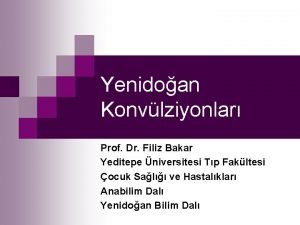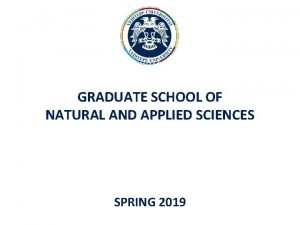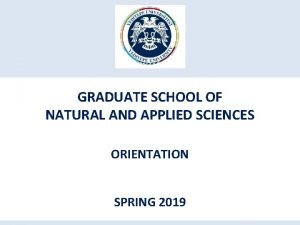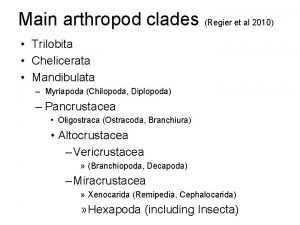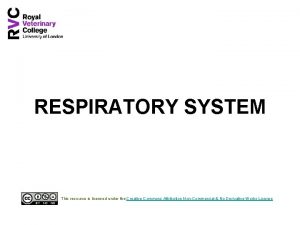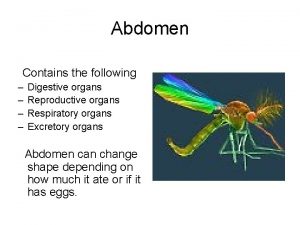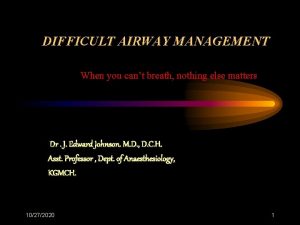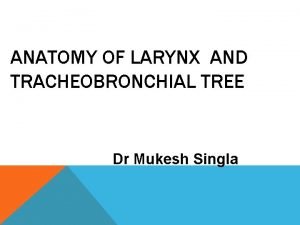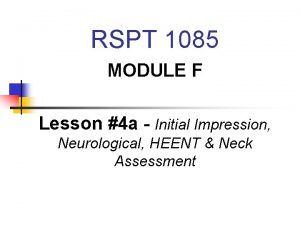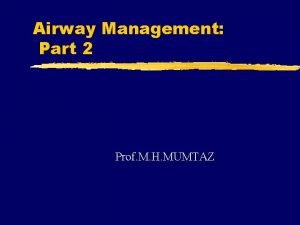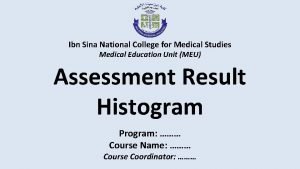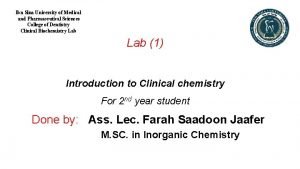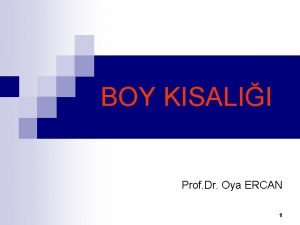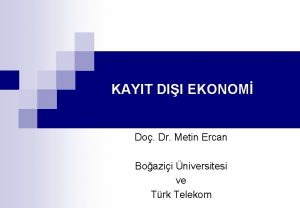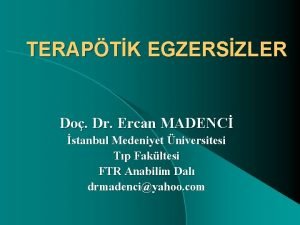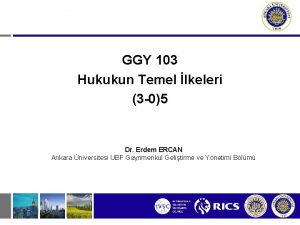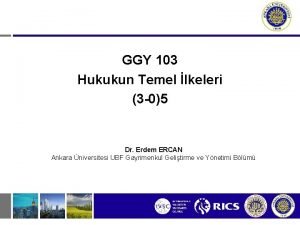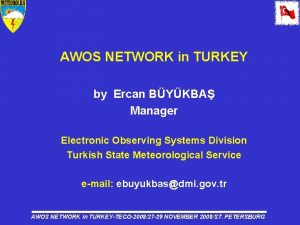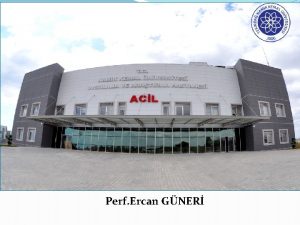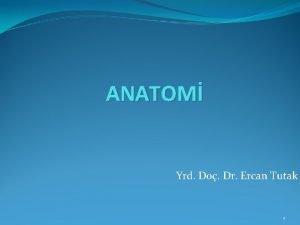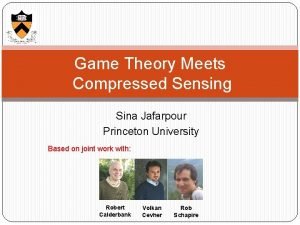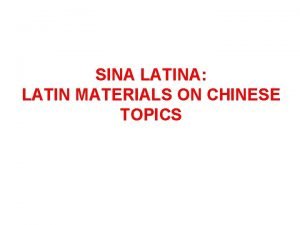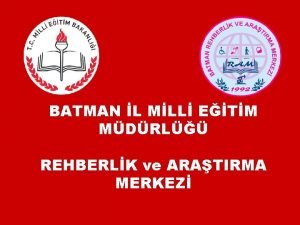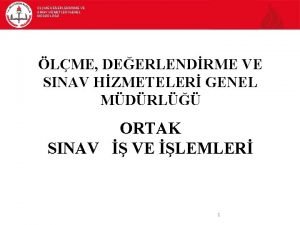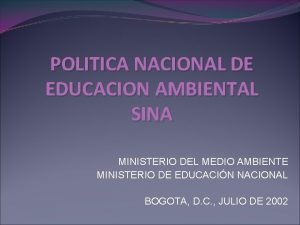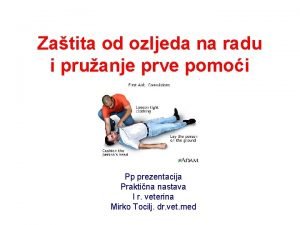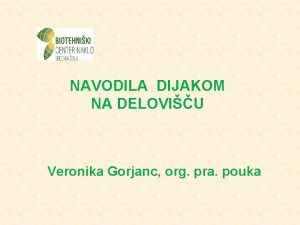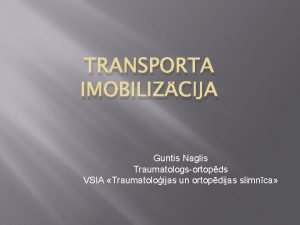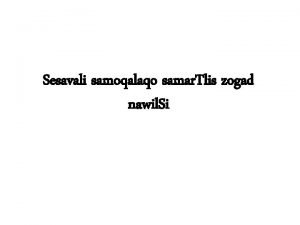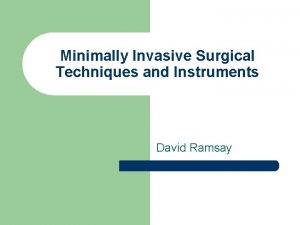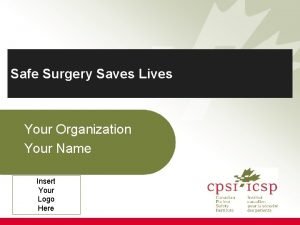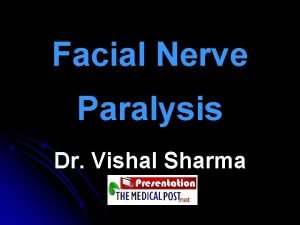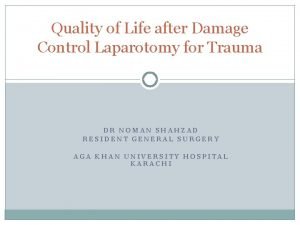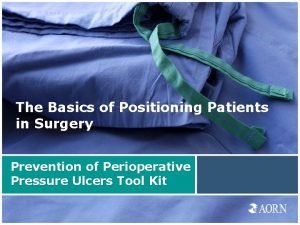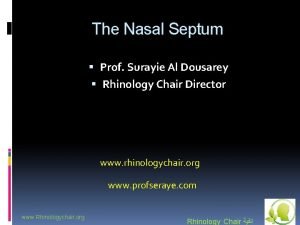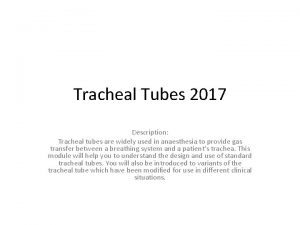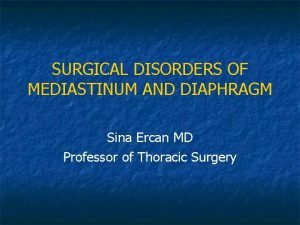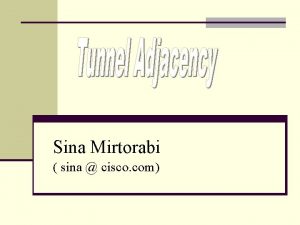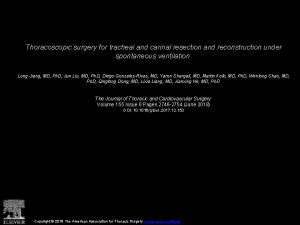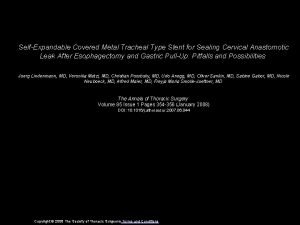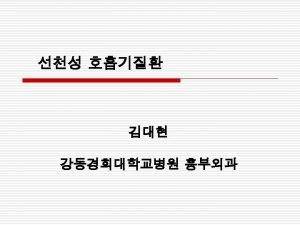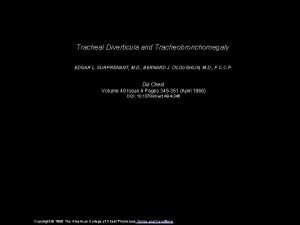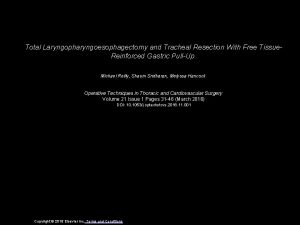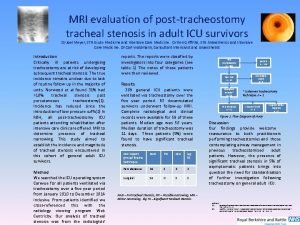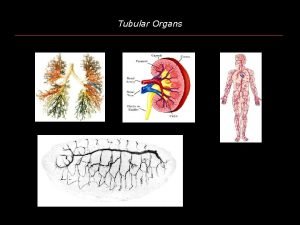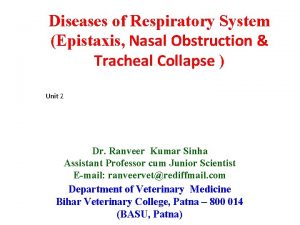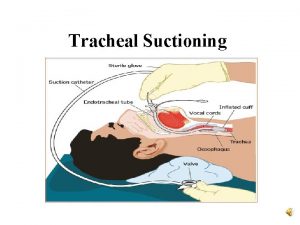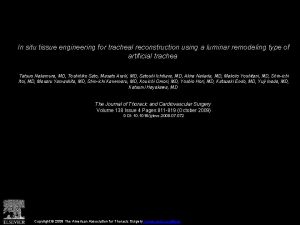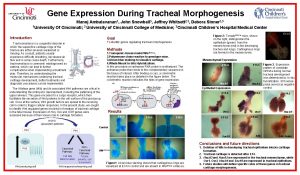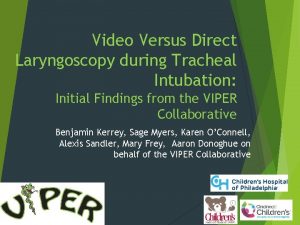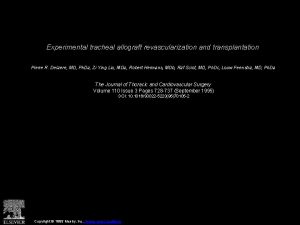Tracheal Surgery Sina Ercan M D Yeditepe University
































































- Slides: 64

Tracheal Surgery Sina Ercan, M. D. Yeditepe University Department of Thoracic Surgery

Lesson: Surgical Pathologies of Trachea and Their Treatment At the end of this lecture, the student should be able to: • List the presenting symptoms of patients with tracheobronchial stenosis • List the major pathologies of trachea • Explain the main role of cervicothoracic somputerized tomography and pulmonary function tests in diagnosing tracheal obstructive pathologies • Define the pathologic cascade of developement in postintubation tracheal stenosis • Explain the initial evaluation and management of patients with tracheal stenosis







Tracheal Stenosis Etiology • Benign stenosis – Idiopathic stenosis – Iatrogenic stenosis • Postintubation stenosis • Due to previous surgical interventions – Traumatic stenosis – Benign tumors and pathologies • Malignant stenosis – Primary malignant tracheal tumors – Secondary malignant tracheal tumors



• Terminal tracheal injury due to high cuff pressure






Diagnosis • Airway obstruction symptoms such as dyspnea, stridor • Patients can be misdiagnosed with asthma and treated for years • Flow-volume loop compression on both phases is typical for airway obstruction

Diagnosis • Flow-volume loop in fixed airway obstrucion

Diagnosis • Preop glottic insufficiency to be searched – Preop awake laryngoscopy – Preop work-up for presence of aspiration – Tracheostomy means previous intubation – look for a distal second lesion – Vocal cords do not move both in paralysis and cricoarythenoid arthritis or traumatic ankylosis

Diagnosis • Stenotic segment calculation to be correct • CT image in supine position may falsly indicate a preglottic stenosis – Overresection – increased anastomotic tension – restenosis • Pediatric trachea tolerates the tension poorly in comparison with adults – Insufficient resection – remaining fibrosis – restenosis

Tracheomalasia

Iatrogenic Laryngotracheal Stenosis • Incorrect tracheostomy applications – Wrong indication – Wrong technique – Wrong care

Iatrogenic Laryngotracheal Stenosis • Incorrect tracheostomy applications – Wrong indication -–- Wrong technique – Wrong care




Iatrogenic Laryngotracheal Stenosis • Incorrect tracheostomy applications – Wrong indication – Wrong technique – Wrong care Care








Iatrogenic Factors • Metal stents in bening tracheal conditions cause elongation of pathologic segment and cause the patient to loose the previously present chance of surgical cure




Iatrogenic Factors • Continuous suturing technique with nonabsorbable suture material resulting in restenosis

• Suture material preference – Nonabsorbable sutures • More calcification in anastomosis • Protruding into the lumen over time, causing granulation – Absorbable sutures • Monofilament • Multifilament • Suture technique – Interrupted suture in pediatric patients • 4/0 sutures in adults and 5/0 in pediatrics

Restenoz

Restenoz


Idiopathic and Postintubation Laryngeal Stenosis

Laryngotracheal Resection Technique • These resections are different and more complex than a regular tracheal resection • Subglottic laryngeal airway is narrow and usually affected by scar formation • Laryngotracheal anastomosis requires at least 6 mm of a healthy distance beyond the vocal cords








Laryngotracheal Resection with Posterior Membrane • Especially postintubation stenosis involves cricoid cartillage 360° • The scar tissue on the posterior cricoid plate needs to be excised




Complications in Laryngotracheal Resections • Vocal cord problems and deglution problems can be symultaneous • Deglution problems usually seen following release techniques – Thyrohyoid > suprahyoid release Also after; - Long segment resection - Advanced age - Presence of neurological problems

Complications in Laryngotracheal Resections • Laryngeal edema is more common after laryngotracheal resection • Postextubation wheezing and stridor • Edema can be differentiated from cord paralysis by examining under mild anesthesia • In edema a #5. 5 – 6 ETT is placed and kept in trachea for a few days, then extubate • If edema continues then tracheostomy placed

Treatment of Complications • Best treatment is to prevent the complications • In tracheal surgery the best chance lies in the first surgery • A T-tube providing a sufficient airway sometimes to be prefered over a risky resection and reconstruction

Treatment of Complications • Minimal aspiration is normal in elderly • If preoperative aspiration was serious and resistant to treatment then a permanent tracheostomy is the right treatment • Postoperative aspiration may improve with physiotherapy over time

Treatment of Complications • A significant complication of laryngotracheal resections is uni- or bilateral vocal cord paralysis • This may improve over time • If persistant, then the cord is fixed in such a position that, it will allow enough phonation while not limiting the breathing

Conclusions • Success in tracheal surgery is highly volume dependent and not appropriate for occasional performance • Preop evaluation is not with only CT but should include physiologic, anatomic and endoscopic evaluation • A dedicated anesthesiologist and an ENT specialist to be included in the team

Conclusions • Proper infrastructure and surgical tools to be available – – Flexsible and rigid endoscopy sets Fast track laryngeal mask Jet ventilator A collection of different size and model T-tubes and tracheostomy tubes • The surgeon to be competent in the old and current literature knowledge and he should always have a B and even a C plan in mind
 Filiz bakar ateş
Filiz bakar ateş Coadsysexam yeditepe
Coadsysexam yeditepe Yeditepe coadsys exam
Yeditepe coadsys exam คือ
คือ Identify the epithelium.
Identify the epithelium. Chromatografia powinowactwa
Chromatografia powinowactwa Reproductive
Reproductive Voice box
Voice box Pharyngo-tracheal lumen airway
Pharyngo-tracheal lumen airway Tracheobronchial
Tracheobronchial Tracheal deviation mnemonic
Tracheal deviation mnemonic Pharyngo-tracheal lumen airway
Pharyngo-tracheal lumen airway Dr beverly fischer md
Dr beverly fischer md Ibn sina national college for medical studies
Ibn sina national college for medical studies Serum vs plasma
Serum vs plasma Oya ercan
Oya ercan Metin ercan boğaziçi
Metin ercan boğaziçi Dr ercan madenci
Dr ercan madenci Dr erdem ercan
Dr erdem ercan Ziya akaroz kimdir
Ziya akaroz kimdir Dr erdem ercan
Dr erdem ercan Www.cografyakulubu.com mehmet ali ercan
Www.cografyakulubu.com mehmet ali ercan Ercan büyükbaş
Ercan büyükbaş Mehmet ali ercan sunuları
Mehmet ali ercan sunuları Kristolloid
Kristolloid Ercan tutak
Ercan tutak Aberrant titan
Aberrant titan Sina mail
Sina mail Sina jafarpour
Sina jafarpour Sina latin
Sina latin Ibn sina muerte
Ibn sina muerte Talatuu
Talatuu Pangngalang tahas halimbawa
Pangngalang tahas halimbawa Kenan keven ibni sina
Kenan keven ibni sina Herra sua mä korotan sanat
Herra sua mä korotan sanat Inialay ni rizal ang orihinal na manuskrito.
Inialay ni rizal ang orihinal na manuskrito. Batman ibni sina mesleki ve teknik anadolu lisesi
Batman ibni sina mesleki ve teknik anadolu lisesi Lme sina
Lme sina Sulayman at indarapatra
Sulayman at indarapatra Principios del sina
Principios del sina U ime oca sina i svetoga duha
U ime oca sina i svetoga duha Kramerova sina
Kramerova sina Ljuljaj sine sina svoga
Ljuljaj sine sina svoga Halimbawa ng iskrip ng programang panradyo
Halimbawa ng iskrip ng programang panradyo Kahulugan ng bato ang puso
Kahulugan ng bato ang puso Principios del sina
Principios del sina Naglis guntis
Naglis guntis Isinulat niya ang banaag at sikat
Isinulat niya ang banaag at sikat Nawil t
Nawil t Jag du han hon vi ni
Jag du han hon vi ni 沈榮麟
沈榮麟 Jhsgr
Jhsgr Robot assisted surgery
Robot assisted surgery Rectory meadow surgery
Rectory meadow surgery Safe surgery saves lives
Safe surgery saves lives Bypass graft surgery
Bypass graft surgery Facial nerve decompression surgery
Facial nerve decompression surgery Ivan yue
Ivan yue Damage control surgery
Damage control surgery Plastic surgery introduction
Plastic surgery introduction Dr steven shapiro
Dr steven shapiro Bracheal plexus
Bracheal plexus Turbenectomy
Turbenectomy Gp lease renewals
Gp lease renewals Cadarache eye
Cadarache eye
